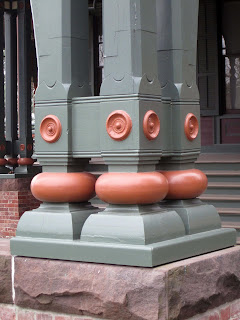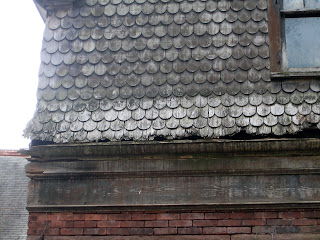
There is a prim 1853 Italianate villa hidden somewhere in here, rather like "Where's Waldo?" What you see instead is a sprawling Queen Anne villa dating from an ambitious 1888 renovation. Arnout Cannon, principal in the Poughkeepsie architectural firm of Cannon and Lloyd, designed it for Robert Bowne Suckley, a typical son of the Hudson River gentry. Ten years after finishing the job, Cannon pointed a gun at his chest and shot himself in the heart. According to a note left behind, he thought he was going insane - a logical sequence when you think about it. It would be cold-hearted, I must say, to connect Cannon's suicide with the design of this house.
The name of the place is Wilderstein, "wild stone" in German. Somebody in the nineteenth century unearthed a petroglyph - being a stone with in this case Native American markings - in the vicinity of the site, hence the name "wild stone." Not really my choice for a house name, but having lived in places called Paxhurst and Daheim, I am in no position to throw... stones. The pretty woman on the left, wearing the polka dot dress, is Margaret "Daisy" Suckley. She lived at Wilderstein for practically all of her one hundred years. This 1943 news photo shows her, her cousin Laura Franklin Delano, and their mutual cousin, Franklin Delano Roosevelt, on a railroad tour of military bases. The president's dog Fala is nearby but out of sight. As was often the case during the war years, Daisy was Roosevelt's frequent companion.

Daisy Suckley was born in 1891 and died at Wilderstein a hundred years later. Her grandfather, Thomas Holy Suckley, built the first house on the site in 1853. Her father, Thomas Bowne Suckley, commissioned Arnout Cannon to renovate it, before moving here from Orange, New Jersey in 1888. As is often the case with inheritors, Suckley was more of a gentleman than an earner. By 1897 Wilderstein, with its twenty-seven estate employees, was already too big a nut for him to cover. Europe being cheaper, Suckley moved the family temporarily to Switzerland. As years passed and his fortune continued to shrink, he undoubtedly endured a string of lifestyle cutbacks. Eventually his unmarried daughter, Daisy, literally ran out of money. Here she is in her nineties, posed in front of the eloquent symbol of her family's fall from economic grace - Wilderstein. Local preservationists, as concerned about her as the house, suggested she donate it to a non-profit group called Wilderstein Preservation, which she did in 1984, subject to a lifetime tenancy.

My house in Millbrook is a stylistic cousin to Wilderstein, except Wilderstein is the cousin who went to boarding school and had the trust fund. Its 1888 interiors are really rather grand, designed by one Joseph Burr Tiffany, cousin to the more famous Louis Comfort Tiffany. Rather like my house being a cousin to Daisy's.

These photos show Wilderstein's interiors as they were when Daisy Suckley lived there. For almost ten years after the house was opened to the public, not much changed. For seven of those years Miss Suckley was herself a part of the furnishings, making smiling appearances and greeting guests.


I have a love-hate relationship with the shredded damask look. I once had a friend who told me her house in London was the definition of shabby chic. She then leaned forward and in a low voice added, "But there is a line between shabby and sordid."


There's a stove hooked into a fireplace in my house too.



It's hard to tell from the photo, but this library has been pressed into service as an old lady's bedroom. The reason: because it's on the first floor. (May heaven preserve me).

Even ladies of distinguished descent, who have spent years in high circles and live in fine houses, can fall into a sort of poverty that is no less shocking for its gentility.

Miss Suckley used to joke that her house hadn't been painted in seventy years. Except it wasn't a joke. During the last years of her life Wilderstein Preservation limited itself to a "hold and roll" operation. Restoration didn't begin in earnest until 1994.

It took sixteen years to do it, but the exterior envelope has now been essentially rebuilt.






The river families knew a thing or two about views. This contemplative prospect is as good a backdrop as any to mention Daisy's close relationship with her cousin, Franklin Roosevelt. No one knows for sure whether or not she was his mistress; one rather hopes that she was. Daisy was more than just an archivist and close personal friend. She was a confidante and companion, close enough to give the president a dog, the famous Fala. Daisy was with FDR in Washington as often as they were together in Dutchess County. She was with him in Warm Springs, Georgia, when he died. When she herself passed away forty-six years later, a trunk-full of personal letters between them was discovered under her bed. Some certainly sound like love letters. I have not read Geoffrey Ward's book, "Closest Companion: the Unknown Story of the Intimate Relationship Between Franklin Roosevelt and Margaret Suckley," but the title suggests a lot of dish.





The glazed porch looked like this at the time of my first visit twenty-five years ago. Terrifying vintage wiring - little ceramic posts, anchored just below the ceiling, on which exposed wires were strung - had been happily disconnected.

Wilderstein Preservation tackled the big tower in 1994, the main roof in 1999, and the west elevation, south elevation and porte cochere in 2000, 2001 and 2002 respectively. The north porch and east elevation came next, in 2003 and 2004, after which they did the main porch and servants' wing. The glazed section of the main porch was finished in 2010. The interiors are next.


See that line of five windows to the right of the porte cochere? That was Daisy's library/bedroom.


Big job, right?



When Daisy's father enlarged the house, he had this remarkable stable built nearby.





It looked more romantic before Wilderstein Preservation hacked away the encroaching jungle.

R. B. S. - Robert Bowne Suckley.


I don't think the main house had degenerated to quite this point, although I understand windows were missing at the top of the tower and the roof was a disaster.


The main stable door, before and after.


It's a wreck, but hugely worthy of preservation.




Until money is raised to restore it, Wilderstein Preservation must just prop it up.

"KEEP OUT" - you betcha.






Located close to the village of Rhinebeck, N.Y., Wilderstein is a National Historic Landmark and one of the contributing properties in the Hudson River Historic District. The house is closed to the public during the depth of winter, but the grounds are open all year long. The link is www.wilderstein.org.

Vintage architectural photos from historic-structures.com.
Thanks for the sharing this. The story is interesting and the home is magnificent. I especially love the porch and porte cochere. It's incredibly satisfying to see a home like this restored, rather than torn down. I hope they are able to do the same with the carriage house.
ReplyDeleteBeautiful home. Well done to all for saving it. I would love to be part of the interior restoration.
ReplyDeletegod bless these brave folk who take on and save these masterpieces. my old ark was last painted in 1952 much to the consternation of the town fathers who want to lure every sucker they can to come to my formerly rural town and build a crackerbox, complain about manure the whole time they live here and move on three years later to be replaced by another complaining sucker. ah - twas always thus.
ReplyDeleteI LOVE this blog so much! I'm also infatuated with everything between Hudson, NY & Rhinebeck, so this was especially enjoyable. Looking forward to more!
ReplyDeleteAlbert J. Gnidica, Hudson River Heritage and
The New York State Museum
Albert Gnidica
Communications Assistant/Special Events
New York State Museum
3025 Cultural Education Center
Albany, NY 12230
518 474-0068
Fax 518 486-3696
agnidica@mail.nysed.gov
www.nysm.nysed.gov
WOW!! This place just blew me away! I can't believe living there, I live in 5 rooms with 5 people and I would die for all that space, or even half.
ReplyDeleteCannon's suicide note stated his poor health was driving him to the point of insanity. Three years before his death, doctors ordered him to cease drawing and reading. As the papers put it at the time, "this comes pretty hard for one in his line of business."
ReplyDeleteIt breaks my heart to think of Daisy Suckley...an undoubtedly very proud and justifiably so Daisy Suckley...living amid this splendid ruin for another 46 years after the end of living in FDR's limelight. Your kitchen shot, with the old wood stove and a newer one among kindling and a wet ceiling, makes my heart ache for Daisy. I know the preservationists who were her friends in her very last years must have been a comfort to her. She deserved so much more.
ReplyDeleteCousin Daisy was cousin to my grandmother. As a child, I visited and played at Wilderstein. Do not feel sad for Daisy, living as she did. She had to be frugal in order to save the estate, and she developed a blind positive optimism. "I think the place looks just fine," was what she said to me when I asked why she didn't paint the place. Her only goal was to be sure it was saved, and it not only has been saved, it has been restored. Bravo to the historic preservation trust and the legions of volunteers who have made Daisy's dream a beautiful public space for reflection and enjoyment.
ReplyDeleteMike Cox
Loved the article but it was kinda sad
ReplyDeleteDiğer blog yazılarınız gibi harika : D, gönderdiğiniz için teşekkürler.
ReplyDelete